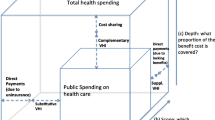Abstract
Aims
Most US states use certificate-of-need (CON) programs in an attempt to slow the growth of health care spending. The objective of this study is to evaluate how CON in fact affects health care spending.
Subjects and methods
With 1980–2009 state-level data on spending from the National Health Expenditure Accounts, this article uses fixed-effects regressions to evaluate how the presence and scope of state CON laws affect these spending outcomes.
Results
This article estimates that CON laws lead to a statistically significant 3.1% increase in total spending and finds that this increase is primarily driven by spending on physicians.
Conclusion
Rather than decreasing health care spending as intended, it appears that CON laws actually increase it. To the extent that policy makers wish to restrain health care spending, they may wish to repeal these laws.
Similar content being viewed by others
Notes
See Koopman and Philpot (2016) for more information.
This table does not represent an exhaustive search of the literature; see Mitchell (2016) for a more thorough review of the literature.
Some of these distinctions are difficult to make; in particular, many physicians work inside hospitals. In this case, spending is counted under physician services if the physicians bill independently from the hospital but under hospital spending if not.
For instance, the instruments used by Lanning et al. (1991) are state-level measures of Medicaid expenditures per capita, budget revenues per capita, percent of insurance premiums that are commercial, hospital beds per capita, percentage of beds in for-profit hospitals, ideology, and the party of the state government. These variables could all affect total spending in ways other than by affecting CON laws, violating the exclusion restriction; this is especially clear in the case of Medicaid spending, which adds directly into total spending.
References
Auster R, Oaxaca R (1981) Identification of supplier induced demand in the health care sector. J Hum Resour 16:327–342
Bailey J (2018) The effect of certificate-of-need laws on all-cause mortality. Health Serv Res 53:49–62
Bailey J, Hamami T, McCorry D (2017) Certificate of need laws and health care prices. J Health Care Finance 43(4):1–7
Conover C, Sloan F (1998) Does removing certificate-of-need regulations lead to a surge in health care spending? J Health Polit Policy Law 23:455–481
Cutler D, Huckman RS, Kolstad JT (2010) Input constraints and the efficiency of entry: lessons from cardiac surgery. Am Econ J: Econ Policy 2:51–76. https://doi.org/10.1257/pol.2.1.51
DeLia D, Cantor JC, Tiedemann A, Huang CS (2009) Effects of regulation and competition on health care disparities: the case of cardiac angiography in New Jersey. J Health Polit Policy Law 34:63–91
Ford JM, Kaserman DL (1993) Certificate-of-need regulation and entry: evidence from the dialysis industry. South Econ J 59:783–791
Grabowski DC, Ohsfeldt RL, Morrisey MA (2003) The effects of CON repeal on Medicaid nursing home and long-term care expenditures. Inquiry 40:146–157
Hellinger F (2009) The effect of certificate-of-need laws on hospital beds and health-care expenditures: an empirical analysis. Am J Managed Care 15:737–744
Ho V (2006) Does certificate of need affect cardiac outcomes and costs? Int J Health Care Finance Econ 6:300–324. https://doi.org/10.1007/s10754-007-9008-9
Koopman C, Philpot A (2016) The state of certificate-of-need laws in 2016. Mercatus Center at George Mason University, Arlington, VA. https://www.mercatus.org/publications/state-certificate-need-laws-2016. Accessed 10/17/18
Lanning J, Morrisey M, Ohsfeldt R (1991) Endogenous hospital regulation and its effects on hospital and non-hospital expenditures. J Regul Econ 3:137–154
Mitchell M (2016) Do certificate-of-need laws limit spending? Mercatus Working Paper, Mercatus Center at George Mason University, Arlington, VA. https://www.mercatus.org/publication/do-certificate-need-laws-limit-spending. Accessed 10/17/18
Rahman M, Galarraga O, Zinn JS, Grabowski DC, Mor V (2016) The impact of certificate-of-need laws on nursing home and home health care expenditures. Med Care Res Review 73:85–105. https://doi.org/10.1177/1077558715597161
Reinhardt HL, Reinhardt HN, Reinhardt UE (1987) Lessons for hospital payment from ornithology. J Policy Anal Manage 6:449–450
Rivers PA, Fottler MD, Frimpong JA (2010) The effects of certificate-of-need regulation on hospital costs. J Health Care Finance 36:1–16
Shortell SM, Hughes EFX (1988) The effects of regulation, competition, and ownership on mortality rates among hospital inpatients. N Engl J Med 318:1100–1107
Stratmann T, Russ J (2014) Do certificate-of-need laws increase indigent care? Mercatus working paper. Mercatus Center at George Mason University, Arlington
Acknowledgements
Thanks to Eleanor Lewin, Michael Kotrous, Anna Chorniy, Mohamad Elbarasse, Matt Mitchell, Tom Hamami, Harry David, participants in the Creighton Business Economic Environment and Policy seminar, the Association of Private Enterprise Education and the American Society of Health Economists 2016 meetings and the International Health Economics Association 2017 for helpful comments. Thanks to the Mercatus Center for financial support and helpful comments.
Author information
Authors and Affiliations
Corresponding author
Ethics declarations
Conflicts of interest
The authors have no conflicts of interest to declare.
Additional information
Publisher’s Note
Springer Nature remains neutral with regard to jurisdictional claims in published maps and institutional affiliations.
Appendix
Appendix
Rights and permissions
About this article
Cite this article
Bailey, J. Can health spending be reined in through supply restraints? An evaluation of certificate-of-need laws. J Public Health (Berl.) 27, 755–760 (2019). https://doi.org/10.1007/s10389-018-0998-1
Received:
Accepted:
Published:
Issue Date:
DOI: https://doi.org/10.1007/s10389-018-0998-1




